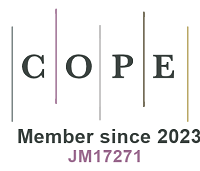REFERENCES
1. Bergmann M, Wirzberger V, Krumpen T, et al. High quantities of microplastic in Arctic deep-sea sediments from the HAUSGARTEN observatory. Environ Sci Technol 2017;51:11000-10.
2. Bergmann M, Mützel S, Primpke S, Tekman MB, Trachsel J, Gerdts G. White and wonderful? Microplastics prevail in snow from the Alps to the Arctic. Sci Adv 2019;5:eaax1157.
3. Dris R, Gasperi J, Rocher V, Saad M, Renault N, Tassin B. Microplastic contamination in an urban area: a case study in Greater Paris. Environ Chem 2015;12:592-9.
4. Gasperi J, Wright SL, Dris R, et al. Microplastics in air: are we breathing it in? Curr Opin Environ Sci Health 2018;1:1-5.
5. Munari C, Infantini V, Scoponi M, Rastelli E, Corinaldesi C, Mistri M. Microplastics in the sediments of Terra Nova Bay (Ross Sea, Antarctica). Mar Pollut Bull 2017;122:161-5.
6. Aves AR, Revell LE, Gaw S, et al. First evidence of microplastics in Antarctic snow. Cryosphere 2022;16:2127-45.
7. Cabrera M, Moulatlet GM, Valencia BG, et al. Microplastics in a tropical Andean Glacier: a transportation process across the Amazon basin? Sci Total Environ 2022;805:150334.
8. Lusher A, Hollman P, Mendoza-Hill J. Microplastics in fisheries and aquaculture - status of knowledge on their occurrence and implications for aquatic organisms and food safety. FAO Fisheries and Aquaculture Technical Paper. 2017;615. Available from: https://oursharedseas.com/wp-content/uploads/2019/11/FAO_Microplastics_in_fisheries_aquaculture.pdf. [Last accessed on 25 Jun 2024].
9. Ragusa A, Svelato A, Santacroce C, et al. Plasticenta: first evidence of microplastics in human placenta. Environ Int 2021;146:106274.
10. Haave M, Gomiero A, Schönheit J, Nilsen H, Olsen AB. Documentation of microplastics in tissues of wild coastal animals. Front Environ Sci 2021;9:575058.
11. Zhu L, Zhu J, Zuo R, Xu Q, Qian Y, An L. Identification of microplastics in human placenta using laser direct infrared spectroscopy. Sci Total Environ 2023;856:159060.
12. Leslie HA, van Velzen MJM, Brandsma SH, Vethaak AD, Garcia-Vallejo JJ, Lamoree MH. Discovery and quantification of plastic particle pollution in human blood. Environ Int 2022;163:107199.
13. Kutralam-Muniasamy G, Shruti VC, Pérez-Guevara F, Roy PD. Microplastic diagnostics in humans: “the 3Ps” progress, problems, and prospects. Sci Total Environ 2023;856:159164.
14. Hu CJ, Garcia MA, Nihart A, et al. Microplastic presence in dog and human testis and its potential association with sperm count and weights of testis and epididymis. Toxicol Sci 2024;200:235-40.
15. Kopatz V, Wen K, Kovács T, et al. Micro- and nanoplastics breach the blood-brain barrier (BBB): biomolecular Corona’s role revealed. Nanomaterials 2023;13:1404.
16. Volkheimer G. Hematogenous dissemination of ingested polyvinyl chloride particles. Ann N Y Acad Sci 1975;246:164-71.
17. Clark NJ, Khan FR, Mitrano DM, Boyle D, Thompson RC. Demonstrating the translocation of nanoplastics across the fish intestine using palladium-doped polystyrene in a salmon gut-sac. Environ Int 2022;159:106994.
18. Al-Sid-Cheikh M, Rowland SJ, Stevenson K, Rouleau C, Henry TB, Thompson RC. Uptake, whole-body distribution, and depuration of nanoplastics by the scallop pecten maximus at environmentally realistic concentrations. Environ Sci Technol 2018;52:14480-6.
19. Mattsson K, Ekvall MT, Hansson LA, Linse S, Malmendal A, Cedervall T. Altered behavior, physiology, and metabolism in fish exposed to polystyrene nanoparticles. Environ Sci Technol 2015;49:553-61.
20. Mattsson K, Johnson EV, Malmendal A, Linse S, Hansson LA, Cedervall T. Brain damage and behavioural disorders in fish induced by plastic nanoparticles delivered through the food chain. Sci Rep 2017;7:11452.
21. Chae Y, An YJ. Effects of micro- and nanoplastics on aquatic ecosystems: current research trends and perspectives. Mar Pollut Bull 2017;124:624-32.
22. Clark NJ, Khan FR, Crowther C, Mitrano DM, Thompson RC. Uptake, distribution and elimination of palladium-doped polystyrene nanoplastics in rainbow trout (Oncorhynchus mykiss) following dietary exposure. Sci Total Environ 2023;854:158765.
23. WHO. Dietary and inhalation exposure to nano- and microplastic particles and potential implications for human health. 2022. Available from: https://www.who.int/publications/i/item/9789240054608. [Last accessed on 25 Jun 2024].
24. Cox KD, Covernton GA, Davies HL, Dower JF, Juanes F, Dudas SE. Human consumption of microplastics. Environ Sci Technol 2019;53:7068-74.
25. Collard F, Gilbert B, Compère P, et al. Microplastics in livers of European anchovies (Engraulis encrasicolus, L.). Environ Pollut 2017;229:1000-5.
26. Wootton N, Sarakinis K, Varea R, Reis-Santos P, Gillanders BM. Microplastic in oysters: a review of global trends and comparison to southern Australia. Chemosphere 2022;307:136065.
27. Daniel DB, Ashraf PM, Thomas SN. Microplastics in the edible and inedible tissues of pelagic fishes sold for human consumption in Kerala, India. Environ Pollut 2020;266:115365.
28. Dawson AL, Li JY, Kroon FJ. Plastics for dinner: Store-bought seafood, but not wild-caught from the Great Barrier Reef, as a source of microplastics to human consumers. Environ Adv 2022;8:100249.
29. Habib RZ, Kindi RA, Salem FA, et al. Microplastic contamination of chicken meat and fish through plastic cutting boards. Int J Environ Res Public Health 2022;19:13442.
30. Karami A, Golieskardi A, Ho YB, Larat V, Salamatinia B. Microplastics in eviscerated flesh and excised organs of dried fish. Sci Rep 2017;7:5473.
31. Catarino AI, Macchia V, Sanderson WG, Thompson RC, Henry TB. Low levels of microplastics (MP) in wild mussels indicate that MP ingestion by humans is minimal compared to exposure via household fibres fallout during a meal. Environ Pollut 2018;237:675-84.
32. Lusher AL, Hurley R, Arp HPH, et al. Moving forward in microplastic research: a Norwegian perspective. Environ Int 2021;157:106794.
33. Miller ME, Hamann M, Kroon FJ. Bioaccumulation and biomagnification of microplastics in marine organisms: a review and meta-analysis of current data. PLoS One 2020;15:e0240792.
34. Shruti V, Kutralam-muniasamy G. Blanks and bias in microplastic research: Implications for future quality assurance. Trends Environ Anal Chem 2023;38:e00203.
35. Bastesen E, Haave M, Andersen GL, Velle G, Bødtker G, Krafft CG. Rapid Landscape changes in plastic bays along the Norwegian coastline. Front Mar Sci 2021;8:579913.
36. Delandmeter P, van Sebille E. The Parcels v2.0 Lagrangian framework: new field interpolation schemes. Geosci Model Dev 2019;12:3571-84.
37. Godø OR, Moksness E. Growth and Maturation of Norwegian coastal cod and Northeast Arctic cod under different conditions. Fish Res 1987;5:235-42.
38. Cote D, Moulton S, Frampton PCB, Scruton DA, Mckinley RS. Habitat use and early winter movements by juvenile Atlantic cod in a coastal area of Newfoundland. J Fish Biol 2004;64:665-79.
39. Mattson S. Food and feeding habits of fish species over a soft sublittoral bottom in the northeast atlantic: 1. COD (GADUS MORHUA L.) (GADIDAE). Sarsia 1990;75:247-67.
40. Bråte ILN, Eidsvoll DP, Steindal CC, Thomas KV. Plastic ingestion by Atlantic cod (Gadus morhua) from the Norwegian coast. Mar Pollut Bull 2016;112:105-10.
41. Bai R, Fan R, Xie C, et al. Microplastics are overestimated due to poor quality control of reagents. J Hazard Mater 2023;459:132068.
42. Haave M, Lorenz C, Primpke S, Gerdts G. Different stories told by small and large microplastics in sediment - first report of microplastic concentrations in an urban recipient in Norway. Mar Pollut Bull 2019;141:501-13.
43. Lorenz C. Detection of microplastics in marine sediments of the German Coast via FT-IR spectroscopy. 2014.
44. Löder MGJ, Imhof HK, Ladehoff M, et al. Enzymatic purification of microplastics in environmental samples. Environ Sci Technol 2017;51:14283-92.
45. Gomiero A, Strafella P, Øysæd KB, Fabi G. First occurrence and composition assessment of microplastics in native mussels collected from coastal and offshore areas of the northern and central Adriatic Sea. Environ Sci Pollut Res Int 2019;26:24407-16.
46. Martinelli M, Gomiero A, Guicciardi S, et al. Preliminary results on the occurrence and anatomical distribution of microplastics in wild populations of Nephrops norvegicus from the Adriatic Sea. Environ Pollut 2021;278:116872.
47. Gomiero A, Haave M, Kögel T, et al. Tracking of plastic emissions from aquaculture industry (TrackPlast). 2020. Available from: https://hdl.handle.net/11250/2649891. [Last accessed on 25 Jun 2024].
48. Primpke S, Wirth M, Lorenz C, Gerdts G. Reference database design for the automated analysis of microplastic samples based on Fourier transform infrared (FTIR) spectroscopy. Anal Bioanal Chem 2018;410:5131-41.
49. Nash R, Valencia AH, Geffen AJ. The origin of fulton’s condition factor - setting the record straight. Fisheriies 2006;31:236-8. Available from:https://api.semanticscholar.org/CorpusID:6908259. [Last accessed on 25 Jun 2024]
50. Gomiero A, Haave M, Bjorøy Ø, et al. Quantification of microplastic in fillet and organs of farmed and wild salmonids-a comparison of methods for detection and quantification. 2020. Available from:https://hdl.handle.net/11250/2687619. [Last accessed on 25 Jun 2024].
51. Abbasi S, Soltani N, Keshavarzi B, Moore F, Turner A, Hassanaghaei M. Microplastics in different tissues of fish and prawn from the Musa Estuary, Persian Gulf. Chemosphere 2018;205:80-7.
52. Akhbarizadeh R, Moore F, Keshavarzi B. Investigating a probable relationship between microplastics and potentially toxic elements in fish muscles from northeast of Persian Gulf. Environ Pollut 2018;232:154-63.
53. Barboza LGA, Lopes C, Oliveira P, et al. Microplastics in wild fish from North East Atlantic Ocean and its potential for causing neurotoxic effects, lipid oxidative damage, and human health risks associated with ingestion exposure. Sci Total Environ 2020;717:134625.
54. Garcia AG, Suárez DC, Li J, Rotchell JM. A comparison of microplastic contamination in freshwater fish from natural and farmed sources. Environ Sci Pollut Res Int 2021;28:14488-97.
55. Gouin T. Toward an improved understanding of the ingestion and trophic transfer of microplastic particles: critical review and implications for future research. Environ Toxicol Chem 2020;39:1119-37.
56. Karami A, Golieskardi A, Choo CK, Larat V, Karbalaei S, Salamatinia B. Microplastic and mesoplastic contamination in canned sardines and sprats. Sci Total Environ 2018;612:1380-6.
57. Wootton N, Reis-Santos P, Dowsett N, Turnbull A, Gillanders BM. Low abundance of microplastics in commercially caught fish across southern Australia. Environ Pollut 2021;290:118030.
58. Lorenz C, Roscher L, Meyer MS, et al. Spatial distribution of microplastics in sediments and surface waters of the southern North Sea. Environ Pollut 2019;252:1719-29.
59. Zeytin S, Wagner G, Mackay-Roberts N, et al. Quantifying microplastic translocation from feed to the fillet in European sea bass Dicentrarchus labrax. Mar Pollut Bull 2020;156:111210.
60. Browne MA, Dissanayake A, Galloway TS, Lowe DM, Thompson RC. Ingested microscopic plastic translocates to the circulatory system of the mussel, Mytilus edulis (L). Environ Sci Technol 2008;42:5026-31.
61. Deng Y, Zhang Y, Lemos B, Ren H. Tissue accumulation of microplastics in mice and biomarker responses suggest widespread health risks of exposure. Sci Rep 2017;7:46687.
62. Neira M. The Minderoo-Monaco Commission on plastics and human health: editorial to accompany the Minderoo-Monaco Commission on plastics and human health in the journal, Annals of Global Health. Ann Glob Health 2023;89:22.







